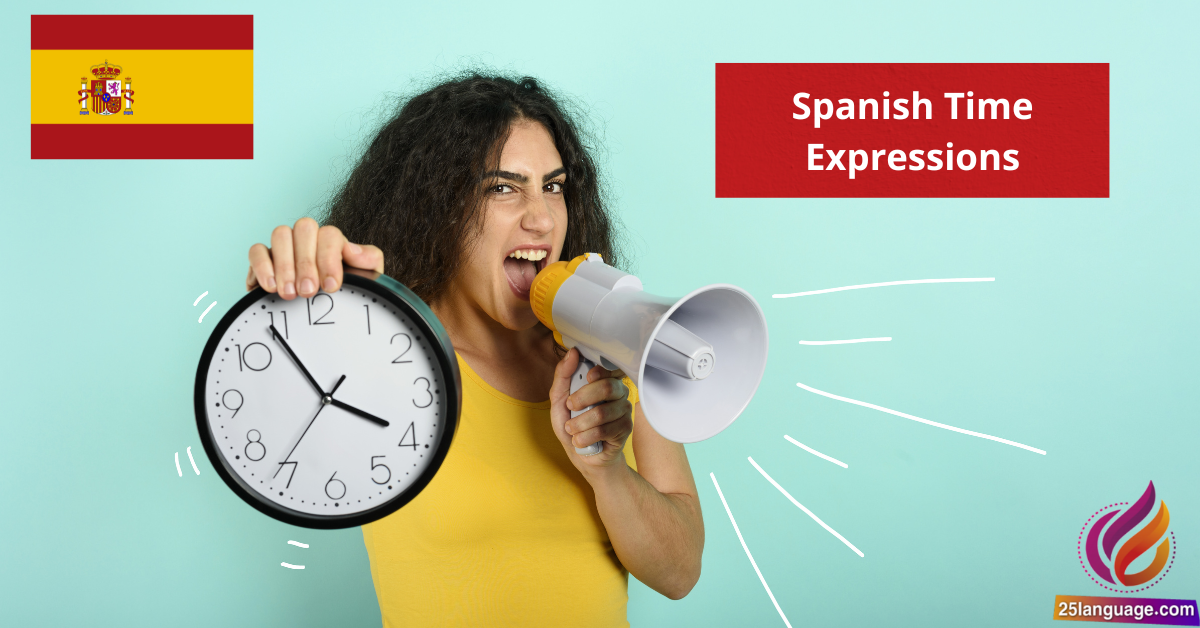Spanish Time Expressions Desde, Hace, Durante

Unlocking the mysteries of time in Spanish can transform how you express ideas and experiences! In this lesson, we’ll explore essential time expressions like “desde,” “hace,” and “durante,” which will help you convey when actions occur with precision and flair. Understanding these terms will enhance your conversations, making them richer and more informative. Get ready to navigate the timeline of events in Spanish, adding depth to your storytelling and daily discussions!
Mastering Spanish Time Expressions for Everyday Conversation
To effectively convey time in Spanish, it is essential to master several key expressions that denote different time frames. These include expressions related to the present, past, and future. Understanding how to use these time expressions can enhance your conversational skills and make your discussions more fluid. Hear are some common time expressions:
- Ahora – Now
- Hoy – Today
- Mañana – Tomorrow
- Ayer – Yesterday
- Esta semana – This week
- El próximo mes – Next month
When expressing specific time on a clock, it’s important to use the verb ser (to be) and to follow a particular structure. For example, in Spanish, we say Son las tres (It is three o’clock) or Es la una (It is one o’clock). To indicate minutes, you would add them after the hour: Son las tres y cinco (It is five past three). for half-past, use y media: Son las tres y media (It is indeed half past three). Below is a table that summarizes some common time expressions and their translations:
| Spanish Expression | English Translation |
|---|---|
| Ahora | Now |
| Hoy | Today |
| Mañana | Tomorrow |
| Ayer | Yesterday |
| Esta semana | This week |
| el próximo mes | Next month |
| Son las tres | It is three o’clock |
| Son las tres y cinco | It is five past three |
| Son las tres y media | It is half past three |
Exploring the Nuances of Desde, Hace, and Durante in Spanish
In Spanish, understanding the nuances of “desde,” “hace,” and “durante” is crucial for conveying time-related concepts accurately. Each of these terms serves a different grammatical function and indicates different temporal relationships. “Desde” is used to denote the starting point of an action or event and is frequently enough translated as “as” or “from.” Such as, “Vivo aquí desde 2010” translates to “I have lived here since 2010.” Key points about “desde” include:
- Indicates a specific point in time.
- Frequently enough used with the present perfect tense.
- Can refer to both definite dates and indefinite time periods.
“Hace,” on the other hand, is used to express the duration of time since an event occurred in the past, commonly translated as “ago.” For example, “Estudié español hace dos años” means “I studied Spanish two years ago.” It provides insight into the passage of time from a past event to the present moment. In contrast, “durante” is utilized to specify a time span within which something occurs, translated as “during.” An example is, “Estuve de vacaciones durante una semana,” meaning “I was on vacation for a week.” The distinctions among these terms can be summarized as follows:
| Spanish Example | Rule | english Translation |
|---|---|---|
| Vivo aquí desde 2010 | Indicates starting point in time | I have lived here as 2010 |
| Estudié español hace dos años | Indicates duration since a past event | I studied Spanish two years ago |
| Estuve de vacaciones durante una semana | Indicates duration of an action | I was on vacation for a week |
Practical Tips for Using time Expressions in Daily Communication
Time expressions in Spanish play a crucial role in everyday conversation,helping you specify when an action occurs or how frequently enough it takes place. One essential aspect to grasp is the use of adverbs of frequency. these are words that express how often something happens. Common examples include siempre (always), a veces (sometimes), and Nunca (never). You can use these adverbs to describe your routine. As an example, you might say, “Siempre desayuno a las ocho”, which translates to “I always have breakfast at eight.” Placing the adverb before the verb is critically important: “Estudio español a veces” (I study Spanish sometimes) follows this pattern.
In addition to frequency adverbs, understanding temporal prepositions is vital for expressing time-related concepts. The prepositions en (in), por (for), and desde (from) are commonly used. For example, to indicate a specific time in the future, you could say, “La reunión es en tres días” (The meeting is in three days). When referring to a duration, use “Voy a trabajar por dos horas” (I’m going to work for two hours). To indicate a starting point, try “Trabajo desde las diez de la mañana” (I work from ten in the morning). Understanding these structures will greatly enhance your ability to communicate effectively.
| Spanish Expression | English Translation | Rule |
|---|---|---|
| Siempre | Always | Use before the verb. |
| A veces | Sometimes | Use before the verb. |
| nunca | Never | Use before the verb. |
| en | in | Indicates a specific future time. |
| por | for | Indicates duration of time. |
| desde | from | indicates starting point in time. |
A Deep Dive into Spanish Temporal Expressions with Clear Examples
Spanish temporal expressions are crucial for denoting time, sequencing events, and establishing the context of actions. Understanding how to use these expressions effectively can significantly enhance your conversational skills. Key temporal expressions include:
- ahora (Now)
- Después (After)
- Antes (Before)
- Hoy (Today)
- Mañana (Tomorrow)
- Pasado mañana (The day after tomorrow)
As an example,one might say Voy a la tienda ahora (I’m going to the store now) to indicate a current action. In contrast, Comeré después de la clase (I will eat after class) shows a future action that follows another event. It’s essential to master these expressions to articulate your thoughts clearly in Spanish. Additionally, the interplay of these terms can define the sequence of actions, such as in Yo limpiaré la casa antes de la cena (I will clean the house before dinner).
| Spanish Example | Grammar Rule | English Translation |
|---|---|---|
| Hoy hago la tarea. | Use of hoy for current day activities. | Today I do the homework. |
| Estudio español cada día. | Indicating frequency with cada día (every day). | I study Spanish every day. |
| Vi a María ayer. | Use of ayer (yesterday) for past events. | I saw María yesterday. |
| Haremos una fiesta el sábado. | Using specific day references in the future. | We will have a party on Saturday. |
| Mañana iré al médico. | Future actions signaled by mañana (tomorrow). | Tomorrow, I will go to the doctor. |
Future Outlook
¡Enhorabuena! Hemos llegado al final de nuestra lección sobre las expresiones de tiempo en español: “desde,” “hace,” y “durante.” Hoy hemos aprendido cómo usar estas expresiones para situar eventos en el tiempo, hablar sobre la duración de acciones y referirnos a momentos específicos en el pasado o en el presente. Es fundamental recordar que,aunque estas palabras pueden parecer complicadas al principio,con práctica y dedicación se convertirán en herramientas útiles para enriquecer tu español.
te animo a que apliques lo que has aprendido hoy en tus conversaciones cotidianas. Intenta describir experiencias pasadas utilizando “hace” o mencionar actividades que has estado realizando “durante” un periodo específico. No dudes en practicar con amigos o incluso frente al espejo. Cada vez que uses estas expresiones,fortalecerás tu confianza y habilidad en el idioma.
Recuerda que aprender un nuevo idioma es un viaje continuo. Aprovecha cada oportunidad para leer, escuchar y hablar en español. ¡Sigue adelante, porque cada esfuerzo cuenta! estoy seguro de que, con dedicación y práctica, dominarás estas expresiones y mucho más. ¡Sigue aprendiendo y hasta la próxima!





























